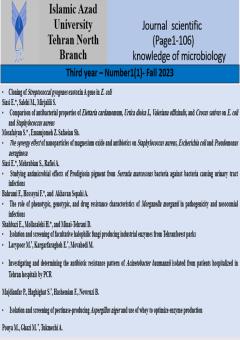Cloning of Streptococcal pyogenes exotoxin gene in E.coli
Subject Areas : Microbiology
elham siasi-torbati
1
,
simin mirjalili
2
![]() ,
میترا صاحی
3
,
میترا صاحی
3
1 - Faculty of Biological Sciences, Tehran-North Branch, Islamic Azad University, Tehran, Iran
2 - Department of Biotechnology, Collage of science, North Tehran Branch, Islamic Azad University, Tehran, Iran
3 -
Keywords: Exotoxin A, Streptococcus pyogenes, speA gene, E.coli XL1Blue, Cloning.,
Abstract :
Aim and Background: Exotoxin A is one of the toxins which produce by group a streptococcuses. This Toxin is a protein soluble substance which causes scarlet fever and different kinds of infections as a super antigen. This toxin has antigenic property and special anti-toxins can neutralize it. In this research, was studied production of Streptococcus pyogenes exotoxin A recombinant protein in E.coli by cloning. Materials and methods: At the first, genome of the bacteria was extracted and used PCR. Then agarose gel electrophoresis was performed for detection of size and quality of the resulting amplicons. According to TA Cloning kit protocol, the target gene was inserted in to the PTG19 Cloning vector and the recombinant plasmid was inserted in to the E.coli XL1Blue bacteria. Eventually checking the sequencing data obtained from cloned gene in the vectore compared with the refrenece sequenece obtained from the NCBI database, confirm the success of the gene cloning by its correct sequence. Results: The results showed that PCR product is a fragment with a length of about 708 bais pairs. This is for the first time that the exotoxin A gene was cloned by the TA Cloning in the PTG19 Cloning vector and the E.coli XL1Blue host cell. The results of sequencing was confirmed presence of Exotoxine A gene, speA. Conclusion: The speA gene was amplified and correct cloning was confirmed by TA Cloning with PTG19 vector and E.coli XL1Blue host cell.
(1) Anderson E L, Cole JN, Olson J, Ryba B, Ghosh P, Nizet V. The fibrinogen-binding M1 protein reduces pharyngeal cell adherence and colonization phenotypes of M1T1 group A Streptococcus. The Journal of Biological Chemistry. 2014; 289(6): 3539–3546.
(2) Yamaguchi M, Terao Y. Kawabata S. Pleiotropic virulence factor - Streptococcus pyogenes fibronectin-binding proteins. Cellular Microbiology. 2013; 15(4): 503–511.
(3) Henningham A, Chiarot E, Gillen CM, Cole JN, Rohde M, Fulde M, Ramachandran V, Cork AJ, Hartas J, Magor G, Djordjevic SP, Cordwell SJ, Kobe B, Sriprakash KS, Nizet V, Chhatwal GS, Margarit IYR, Batzloff MR, Walker MJ. Conserved anchorless surface proteins as group a streptococcal vaccine candidates. Journal of Molecular Medicine. 2012; 90 (10): 1197-1207.
(4) Radcliff FJ, Fraser JD, Proft T. Vaccination with Streptococcus pyogenes nuclease A stimulates a high antibody response but no protective immunity in a mouse model of infection. Medical Microbiology and Immunology. 2015; 204(2): 185-191.
(5) Sheel M, Moreland NJ, Fraser JD, Carapetis J. Development of Group a streptococcal vaccine global health need. Expert Review of Vaccines. 2016; 15(2): 227-238.
(6) Eftekharivash L, Farajnia S, Najar Peerayeh Sh, Tanomand A. Optimization of expression and in vitro characteristics evaluation of Pseudomonas aeruginosa recombinant exotoxin A (domains I and II). Journal of North Khorasan University. 2015; 7(3): 495-507.
(7) Smoot LM, McCormick JK, Smoot JC, Hoe NP, Strickland I, Cole RL, Barbian KD, Earhart CA, Ohlendorf DH, Veasy G, Hill HR, Leung DYM, Schlievert PM, Musser JM. Characterization of Two Novel Pyrogenic Toxin Superantigens Made by an Acute Rheumatic Fever Clone of Streptococcus pyogenes Associated with Multiple Disease Outbreaks. Infection and Immunity. 2002; 70(12): 7095–7104.
(8) Steer AC, Batzloff MR, Mulholland K, Carapetis JR. Group a streptococcal vaccines facts versus fantasy. Current Opinion in Infectious Diseases. 2009; 22(6): 544-552.
(9) Wang N, Mattis DM, Sundberg EJ, Schlievert PM, Kranz DM. A Single Engineered Protein Therapeutic Agent Neutralizes Exotoxins from Both Staphylococcus aureus and Streptococcus pyogenes. Clinical and Vaccine Immunology. 2010; 17(11): 1781-1789.
(10) Zhang Sh, Green NM, Sitkiewicz I, LeFebvre RB, Musser JM. Identification and Characterization of an Antigen I/II Family Protein Produced by Group AStreptococcus. INFECTION AND IMMUNITY. 2006; 74(7): 4200–4213.
(11) Ulric R. Vaccine based on a ubiquitous cysteinyl protease and streptococcal pyrogenic exotoxin A protects against Streptococcus pyogenes sepsis and toxic shock. Journal of Immune Based Therapies and Vaccines. 2008; 6: 1-8.
(12) Hamada S, Kawabata S, Nakagawa I. Molecular and genomic characterization of pathogenic traits of group A Streptococcus pyogenes. Proc Jpn Acad Ser B Phys Biol Sci. 2015; 91(10): 539-559.
(13) McCormick JK, Pragman AA, Stolp JC, Leung DTM, Schlievert PM. Functional Characterization of Streptococcal Pyrogenic Exotoxin J, a Novel Superantigen. Infection and Immunity. 2001; 69(3): 1381–1388.
(14) Reichardt W, Müller H. Erythrogenic toxins A, B and C occurrence of the genes and exotoxin formation from clinical Streptococcus pyogenes strains associated with streptococcal toxic shock-like syndrome. FEMS microbiology letters. 1992; 100(1-3): 313-322.
(15) Yamamoto M, Ferretti JJ. High level expression of Streptococcus pyogenes erythrogenic toxin A ( SPE A) in Escherichia coli and its rapid purification by HPLC. FEMS Microbiology Letters. 1995; I32: 209-2I3.
(16) Moradkhani A, Abtahi H, Pakzad I, Karimi M. Antigenic characteristics of recombinant hyaluronidase A of Streptococcus pyogenes expressed in E. coli. Arak Medical University Journal . 2012; 14(55): 72-80.
(17) Njadmoghadam MR, Modaresi M, Babashamsi M, Chamankhah M. Streptokinase: extraction, cloning and high expression of active recombinant protine with facility in purification. Journal of shahid beheshti medical science University. 2006; 30(3): 245-252.


